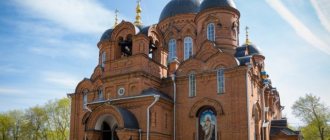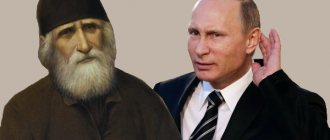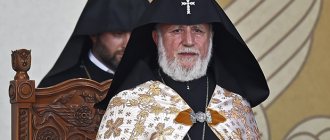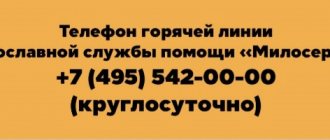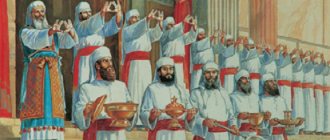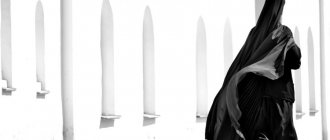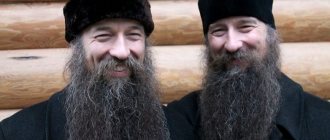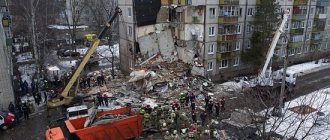One of the bloodiest pages in the formation of the Bolshevik regime in Russia was the campaign to destroy the Orthodox Church and plunder churches. It began by personal order of Vladimir Lenin in 1922. The Bolshevik leadership carried it out under the slogan of fighting famine in the Volga region, but the reason, of course, was completely different.
The Bolsheviks could not allow the Russian people to believe in anything other than a “bright communist future.” And for this it was necessary to erase the Orthodox faith from people’s consciousness at any cost. The result of the “spiritual and social experiment” was rivers of blood from hundreds of brutally murdered priests and ordinary parishioners.
Famine in the Volga region
As already mentioned, the beginning of a large-scale anti-church campaign in Bolshevik Russia dates back to 1922 and took place under the slogan of fighting hunger in the Volga region and other regions. However, this was just a ruse. And that's why. Indeed, the famine in the Volga region became one of the most terrible pages in the revolutionary history of Russia. It covered more than 22 million people; by May 1922, more than five million people died of hunger in the Volga region, the Urals, Kazakhstan, and Ukraine.
Then the Bolsheviks blamed everything on the bad harvest of 1921. But in fact, the famine was provoked by themselves. Including terrible surplus appropriations, when everything was confiscated from the peasants - down to the last grain. At this time, perhaps the only organization in Russia that really tried to save people from starvation was the Orthodox Church. It was she who created the first Church Committee for Famine Relief in Russia, whose activities the Bolsheviks tried in every possible way to interfere with.
Patriarch Tikhon, who then headed the Russian Orthodox Church (ROC), managed to organize a massive collection of funds among parishioners to purchase bread. His appeals to believers are well known: “We again appeal to all who hold the covenants of Christ dear, with an ardent plea for relief from the terrible condition of the hungry. You, Orthodox Christians, responded with your donations to our first call. The scourge of famine has grown to its extreme. Extend your hands to help your starving brothers and sisters, sharing with them both a piece of bread and clothing according to the commandments of Christ.”
Patriarch Tikhon
When the Bolsheviks saw that it was the church that really helped people, and realized that the Russian Orthodox Church could seriously compete with their power, instead of saving people from starvation, they carried out bloody anti-church terror. It should be noted that the mass robbery of churches, that is, the confiscation of church valuables from the Russian Orthodox Church, was in fact a secondary phenomenon. In the first place, however, was the struggle for power, for the minds of the people of a country with a population of many millions, for the replacement of traditional Christian values with communist slogans.
The fact is that the fight against the church and religion began two years before the campaign to confiscate valuables. In 1919, in his letter to Dzerzhinsky, Lenin was completely frank: “...It is necessary to put an end to priests and religion as quickly as possible. Popovs should be arrested as counter-revolutionaries and saboteurs, and shot mercilessly and everywhere. And as much as possible. Churches are subject to closure. The temple premises should be sealed and turned into warehouses.”
Well, if at the same time there is also the opportunity to profit from the values that the Orthodox Church has collected for centuries, then the Bolsheviks never gave up such prospects.
Execution of priests under Lenin
Formally, the campaign to confiscate church valuables for the benefit of the starving Volga region began in 1922, when on January 2 the All-Russian Central Executive Committee issued a decree “On the liquidation of church property.” At that time, the Bolsheviks were still afraid of the mass unrest that such a sharp attack against Orthodoxy could cause, so the resolution stipulated that valuables would be confiscated that “would not have a significant impact on the performance of religious rites.” However, who paid attention to this clause! The resolution was put into effect, that is, fanatics of all stripes and outright bandits who hastily signed up as Bolsheviks were given the command “fas”.
Horrible atrocities began in the country. Churches were robbed to the ground, and priests were not only shot. They were burned alive along with their families and small children, buried in the ground, and tortures were invented for them that even the Holy Inquisition could not think of. Much later, when documents from the Bolshevik archives were declassified, it became clear that in 1922 alone, 2,691 priests, 1,962 monks, and 3,447 nuns were brutally tortured and killed. It is clear that the mass murders of church ministers and the robberies of churches could not take place without resistance in Russia, which lived by Orthodoxy for many centuries.
Patriarch Tikhon again addressed both Russian believers and the Orthodox Church abroad, in which he sharply condemned what the Bolsheviks were doing. And although the patriarch did not call for armed resistance to the authorities, ordinary believers could not calmly watch the destruction of churches.
In the first half of 1922 alone, the campaign of murdering priests and looting churches caused more than 1,400 incidents of bloody clashes. There were 231 trials related to these events; 732 people, mostly clergy and monks, were in the dock.
Why were priests shot in the USSR?
Pavel Florensky was born on January 9, 1882 in Transcaucasia, near the town of Yevlakh, Elisavetpol province (Azerbaijan), in the family of a railway engineer. After graduating from the academy, he began teaching philosophical disciplines there, and in 1911 he accepted the priesthood and was appointed editor of the academic journal Theological Bulletin.
From 1916, Florensky worked for nine years in the Commission for the Protection of Monuments of Art and Antiquity of the Trinity-Sergius Lavra as a scientific secretary and wrote a number of works on ancient Russian art. In May 1928, the United State Political Directorate carried out a large-scale operation in Sergiev Posad and its environs and arrested a large group of believers - church ministers and parishioners. This event was preceded by a powerful “artillery preparation” (the organization is prohibited in Russia): newspapers and magazines printed from issue to issue accusatory, angry pamphlets and feuilletons about the “counter-revolutionary spawn” entrenched in the city - “Nest of the Black Hundreds near Moscow!”, “Trinity-Sergius Lavra” - a refuge for former princes, factory owners and gendarmes!”, “The Shakhovskys, Olsufievs, Trubetskoys and others are conducting religious propaganda!”
Florensky was arrested on May 21. The convicted priest was deported to the East Siberian Svobodny camp, where he was assigned to work in the research department of the BAMLAG administration. In 1934, he was sent with a special convoy to the Solovetsky special purpose camp, where the priest worked on the problem of iodine extraction and patented more than ten scientific discoveries. Three years later he was sentenced to capital punishment and executed.
During the persecution of the church, tens of thousands of clergy came under repression.
According to the government commission for the rehabilitation of victims of political repression, in the period from 1937 to 1941 alone, 175.8 thousand priests were arrested, of which 110.7 thousand were shot.
By the spring of 1938, out of 25 thousand churches in the USSR, only 1,277 churches remained, and 1,744 churches ended up on the territory of the Union after the western regions of Ukraine, Belarus and the Baltic states joined it. Among the demolished temples there were truly iconic places. Thus, on June 2, 1931, by order of Stalin, the Cathedral of Christ the Savior was scheduled for demolition. In its place, it was planned to build another “temple” - a huge Palace of the Soviets, which was to be crowned with a grandiose statue of Lenin. After the first explosion, the Temple survived; a second layer of explosives had to be laid. Subsequently, it took almost a year and a half just to sort out the wreckage. The construction of the Palace of Soviets, begun in 1937, was never completed due to the Great Patriotic War. For many years, the site of the blown-up Temple was empty, and in 1960 the Moscow swimming pool appeared there. At the end of 1994, the pool was demolished to restore the Cathedral of Christ the Savior.
After the revolution, the Moscow Passion Monastery also suffered a sad fate. Artists painted the walls with anti-religious slogans, and in March 1919 the Military Commissariat moved there. At one time, students of the “Communist University of the Toilers of the East” coexisted there with the last nuns who refused to leave their cells. Later, the monastery was transferred to the Central Archives, and in 1928, the Central Anti-Religious Museum was opened within the walls of the former monastery. Strastnaya Square was renamed Pushkinskaya. The monastery was completely demolished in 1937 “for the purposes of anti-religious propaganda.”
Temples continued to be closed until the Great Patriotic War.
The Soviet authorities partially revised their position only after it became known that the Germans were not preventing the opening of churches and that 3,732 churches had already been opened in the occupied territories - more than in the entire Union.
The head of the Main Directorate of Reich Security of the Third Reich, Reinhard Heydrich, sent instructions to the highest ranks of the SS and security police, in which he indicated the following: “Do nothing against the aspirations of the Orthodox Church to extend its influence to the masses. On the contrary, to assist them in every possible way, and initially to insist on the principle of separation of church and state and to avoid the unity of the church. Also, do not interfere with the formation of religious sects.”
In 1943, the Soviet government demonstrated a change in its attitude towards the Russian Orthodox Church with the opening of the Council of Bishops and the elevation of Metropolitan Sergius to the rank of patriarch. However, this did not mean that the situation had improved. Soon after the first manned flight into space, Nikita Khrushchev grinned: “Gagarin was in space - he didn’t see God.” The phrase became the motto for anti-religious persecution in the USSR. Not as brutal as in the 20s and 30s, but more methodical, consistent and large-scale. Temples were now less likely to be blown up, preferring to turn them into warehouses, vegetable warehouses and even beer halls. Priests were forced to “convert to atheism.”
In 1962, two resolutions of the CPSU Central Committee appeared, calling for the introduction of tough measures to suppress the spread of religious ideas among children and youth. A proposal was put forward to deprive fathers and mothers who raised children in a religious spirit of parental rights. Parents began to be called to the school and to the police, demanding that they not take their children to the temple, otherwise they would be threatened with a boarding school.
Easter caused the greatest discontent. To ensure that as few people as possible came to churches, townspeople began to be driven out to Lenin's subbotniks, Sundays and mass processions with stuffed priests, which were then burned. On this day, anti-Easter lectures were also held: children were told that Easter festivities breed drunkards and hooliganism. Collective farm brigades tried to send them to work further out in the fields, and children were taken on field trips, for ignoring which parents were called to school. On Good Friday, a mournful day for believers that should be spent in silence, schools often held dances.
Even the October students were instructed to re-educate irresponsible relatives, otherwise they would face reprimands and spoiled characteristics. In order to “stop and eradicate” in time, district committees and party committees sent their raids to all-night vigils. Barriers of teachers, cordons of Komsomol members, detachments of vigilantes on duty stood under churches all night, catching students and colleagues in the crowds.
As a result, believers began to confess in absentia for the holiday: a person passed a note with a list of sins to the priest through his messengers, and he released them in writing or imposed penance.
Since there were only a few functioning churches left, going to the all-night vigil turned into a whole pilgrimage.
Neither the believers nor the priests were going to give up. Thus, in the memoirs of the famous restorer Savva Yamshchikov, there is a story about how Archimandrite Alypiy, the abbot of the Pskov-Pechersk Monastery, demonstratively burned the paper about its closure in front of the “sovereign envoys.” And then he turned to the cell attendant and said: “I’d rather accept martyrdom, but I won’t close the monastery. Father Cornelius, give me an ax here, we’ll chop off heads!” The temple was saved.
During the first years of Mikhail Gorbachev's rule, the official attitude of the Soviet state towards religion remained cool, but the government was already beginning to gradually lean towards cooperation with religious organizations.
The most significant changes began in 1988-1989. In 1988, the Council for Religious Affairs under the Council of Ministers of the USSR abolished the rule that prayer buildings are the property of the state; in 1990, the USSR Law “On Freedom of Conscience and Religious Organizations” was adopted. In 1990, the RSFSR Law “On Freedom of Religion” was passed, which allowed the optional study of religion in general education institutions, and also abolished any control over the religion of citizens. In October 1990, on the basis of this law, the Decree on the separation of church and state and school from church was repealed.
